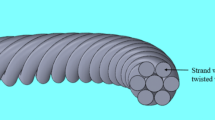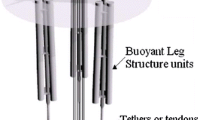Abstract
Offshore triceratops is new-generation offshore platform, whose novel geometric form is advantageous and safe in ultra-deep waters. Deck is partially isolated from the buoyant legs by ball joints. Buoyant legs are anchored to sea bed using taut-moored tether with high initial pretension. Compliant nature of the platform induces degree of flexibility with large time periods; they fall within the range of wind-excitation frequency, making them vulnerable under aerodynamic loads. As tethers are crucial component in compliant structures such as triceratops, this study aims at investigating the effect of combined action of wind, wave and current on dynamic tension variation caused in tethers. It is followed by fatigue life prediction under different sea states. Statistical analyses of tether tension variation show that it is periodic in nature; maximum number of cycles is found to be in low sea state. Presence of current enhances energy of tension spectrum significantly. There is an increase in service life of tethers in the presence of wind under different sea states; but presence of current reduces the service life of tethers.








Similar content being viewed by others
Abbreviations
- AC:
-
Aerodynamic centre
- API:
-
American Petroleum Institute
- CG:
-
Centre of gravity
- FD:
-
Fatigue damage
- H S :
-
Significant wave height
- N :
-
Number of allowable cycles
- n :
-
Number of counts from the histogram
- ω:
-
Frequency
- ω p :
-
Peak frequency
- PM:
-
Pierson–Moscowitz
- PSD:
-
Power spectral density
- RMS:
-
Root mean square
- \({\sigma _u}{(z)^2}\) :
-
Variance
- T z :
-
Zero-crossing period
- θ :
-
Frequency ratio
- z :
-
Reference height (= 10 m)
- z s :
-
Surface height (= 20 m) variance
References
S. Chandrasekaran, S. Madhuri, A.K. Jain, Aerodynamic response of offshore triceratops. Ships Offshore Struct. 8(2), 123–140 (2013)
C.N. White, R.W. Copple, C. Capanoglu, Triceratops: An Effective Platform for Developing Oil and Gas Fields in Deep and Ultra Deep Water, 15th edn. (Offshore and Polar Engineering Conf., Japan, 2005)
S. Chandrasekaran, S. Madhuri, Dynamic response of offshore triceratops: numerical and experimental investigations. Ocean Eng. 109, 401–409 (2015)
Y. Zhao, J. Yang, Y. He, M. Gu, Dynamic response analysis of a multi-column tension-leg-type floating wind turbine under combined wind and wave loading. J. Shanghai Jiaotong Univ. Sci. 21(1), 103–111 (2016)
A.K. Jain, S. Chandrasekaran, Aerodynamic Behaviour of Offshore Triangular Tension Leg Platforms. (In: Fourteenth international offshore and polar engineering conference, Osaka, 2004)
T.T. Tran, D.H. Kim, Fully coupled aero-hydrodynamic analysis of a semi-submersible FOWT using a dynamic fluid body interaction approach. Renew. Energy. 92, 244–261 (2016)
M. Shen, Z. Hu, G. Liu, Dynamic response and viscous effect analysis of a TLP-type floating wind turbine using a coupled aero-hydro-mooring dynamic code. Renew. Energy. 99, 800–812 (2016)
S. Chandrasekaran, Dynamic Analysis and Design of Ocean Structures, 2nd edn. (Springer, Singapore, 2017)
M.M. Zaheer, N. Islam, Stochastic response of a double hinged articulated leg platform under wind and waves. J. Wind Eng. Ind. Aerodyn. 111, 53–60 (2012)
D.V. Reddy, A.S. Swamidas, 2013. Essentials of Offshore Structures: Framed and Gravity Platforms. (CRC Press, Boca Raton, 2013)
S. Liapis, S. Bhat, C. Caracostis, C. Webb, C. Lohr, Global Performance of the Perdido Spar in Waves, Wind and Current–Numerical Predictions and Comparison with Experiments. (In: Offshore Mech and Arctic Engg Conf., Texas, 2010)
DNV G. Recommeded Practice DNVGL-RP-0005: 2014-06 RPC203: Fatigue Design of Offshore Steel Structures (2014)
A. Fernández-Canteli, S. Blasón, J.A.F.O. Correia, A.M.P. De Jesus, A probabilistic interpretation of the Miner number for fatigue life prediction. Fratturaed Integr. Strut. (30), 327–339 (2014)
S. Blasón, J.A.F.O. Correia, A.M. De Jesus, R.A. Calçada, A. Fernández-Canteli, A probabilistic analysis of Miner’s law for different loading conditions. Struct. Eng. Mech. 60(1), 71–90 (2016)
Author information
Authors and Affiliations
Corresponding author
Rights and permissions
About this article
Cite this article
Chandrasekaran, S., Nagavinothini, R. Tether analyses of offshore triceratops under wind, wave and current. Mar Syst Ocean Technol 13, 34–42 (2018). https://doi.org/10.1007/s40868-018-0043-9
Received:
Accepted:
Published:
Issue Date:
DOI: https://doi.org/10.1007/s40868-018-0043-9




